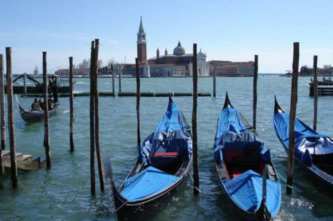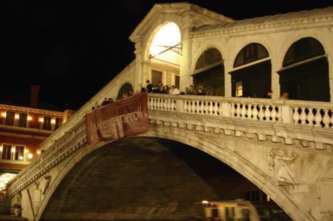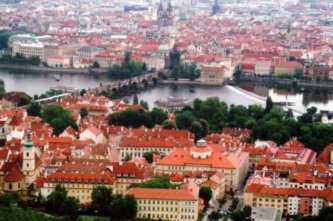
San Marco square, Venice
Venice
It seems true to say that Venice became widely known in England following the publication of Shakespeare’s plays. He liked to put his characters to distant and exotic places. Venice was firstly used as a location in ‘Othello’ and then in ‘The Merchant of Venice’, which contained more details about a beautiful city built on water.
It still fascinates us how Shakespeare managed to express the atmosphere of Venice without ever visiting it. At his time, only a few people could ever go to Italy. Of course, it would take them several days, provided they were not attacked by pirates. Fortunately, nowadays the city is much more accessible for all travellers.
Venice is unique in many ways and although you might know that all churches and palaces are actually built on wooden piles, it is hard to realise how complicated it was to construct them. Santa Maria della Salute, a small church in the Grand Canal, for example, was built on a platform made of approximately 100,000 wooden piles, and each of them had to be installed manually.

photo by Zair Kashek
The most significant event in its history, that later helped the city to gain a special status among Christians, happened in 828. The relics of St. Mark the Evangelist were brought from Alexandria and placed in the new cathedral, built specifically for this purpose.
The cathedral, Basilica di San Marco, is still there, on its original site in San Marco square. If you are making a list of places to visit, San Marco should definitely be the first. While conquering Italy, Napoleon was so impressed so that he called it ‘the drawing room of Europe’. It is still the biggest square in the city with almost nine sites listed in UNESCO World Heritage: Doge's Palace, San Marco cathedral, Campanile, Lodgetta, Old clocktower, Procuratie Vecchie (Old arcades), the Napoleonic Wing (New arcades), St. Mark’s library and The Bridge of Sighs.
The first thing that surprises you here is a lack of modern transport. Most cities around the world have metro, traffic lights or cars. Here there are no roads, no cars and no streets, to which we are used to. It also helps to understand to what extent the technology have changed our lives.

photo by Zair Kashek
Currently Venice is more famous for its cultural life than its past. It is claimed that Europe’s first opera house was founded here, nearby Antonio Vivaldi’s birthplace.
A famous annual Carnival of Venice attracts thousands of tourists. Celebrated from 1296, the carnival made Venetian Masks known all over the world.
If you are lucky enough to arrive here in late August or early September, you will probably see world’s oldest film festival, Mostra Internazionale d'Arte Cinematografica di Venezia (Venice Film Festival) which takes place on Lido, one of small islands in the lagoon. It is considered one of the most prestigious in its kind. The previous winners of the Golden Lion included people like Tom Stoppard, Ingmar Bergman, Steven Spielberg, Martin Scorsese and Francis Ford Coppola.
You should also keep in mind that Venice is not very suitable for winter getaways. During this period it is so-called Acqua Alta season, when the whole city is flooded. Fortunately, it does not last long, and after the rain stops, Venice recovers its beauty.
Prague
It has been mentioned already that Venice is a beautiful place to visit, but if you prefer to have ground under your feet, you might go to Prague instead.
Since 2004 when Czech Republic joined the European Union, it became easier to organise the trip. In fact, you have probably seen Prague already without even knowing it: many Hollywood films were shot here, including Amadeus (Miloš Forman), Mission Impossible (Tom Cruise), From Hell (Johnny Depp), League of Extraordinary Gentleman (Sean Connery), The Brothers Grimm (Heath Ledger) and some parts of Casino Royale.
The reason why the directors choose the city is a large area full of well-preserved Medieval buildings. Called the European city of culture in 2000, Prague is often referred to as ‘the city of a hundred spires’. It is particularly true as there are currently about 500 towers in the city.

There are different views on the origin of the city. Historians believe it started in 870, when the castle was constructed. The legend, however, claims that Prague appeared following a prophecy made by a woman from local tribe, who called it “a city whose glory will rise to the stars”. The city obviously had some glorious years, but it also underwent one of the most horrifying genocides when almost 36,000 Jews died in Auschwitz.
Today Prague is the 6th most visited city in Europe due to its range of architectural styles from Roman structures to 20th century Art Nouveau houses. The Prague Castle is the largest palace complex in the world. Today it is used as President’s residence and a Treasury with Czech Crown jewels. There is a scary legend associated with St. Wenceslas Crown: anyone who puts it on his head unjustly will die violently within one year (it is believed that Reichsprotektor Reinhard Heydrich did it just before his assassination).
One of the most unusual attractions within the castle area is on the wall of Old Town City Hall. The Prague Astronomical Clock (Prague Orloj) was constructed in 1410 by a local clockmaker called Hanuš. Apart from showing time, the Clock also includes Zodiacal rings, astronomical signs and moving sculptures. Unfortunately, after he finished the work, Hanuš was blinded so that he would not be able to make the same clock for any other city.

If all these did not convince you to visit the city, you should also consider the fact that Czech Republic is relatively cheaper compared to other EU countries. The country still uses Czech koruna as its official currency but euro is also widely accepted.
It is surprising how Prague has been invaded many times throughout its history but its historic centre remained unchanged. Architectural styles just followed each other so that there are three different district systems which are not compatible with each other. It might make your journey slightly complicated but at the same time gives you an idea how a medieval city was organized.
Prague is best accessible via Ruzyně International Airport with many budget airlines connecting it to other European cities.
by Zair Kashek
More in this series:
Places to see in 2009: Quebec city and Hawaii
Places to see in 2009: Germany and Denmark
Places to see in 2009: Warwick Castle and Stonehenge
Places to see in 2009: Eden Project and Cadbury World
Tagged in Travel

